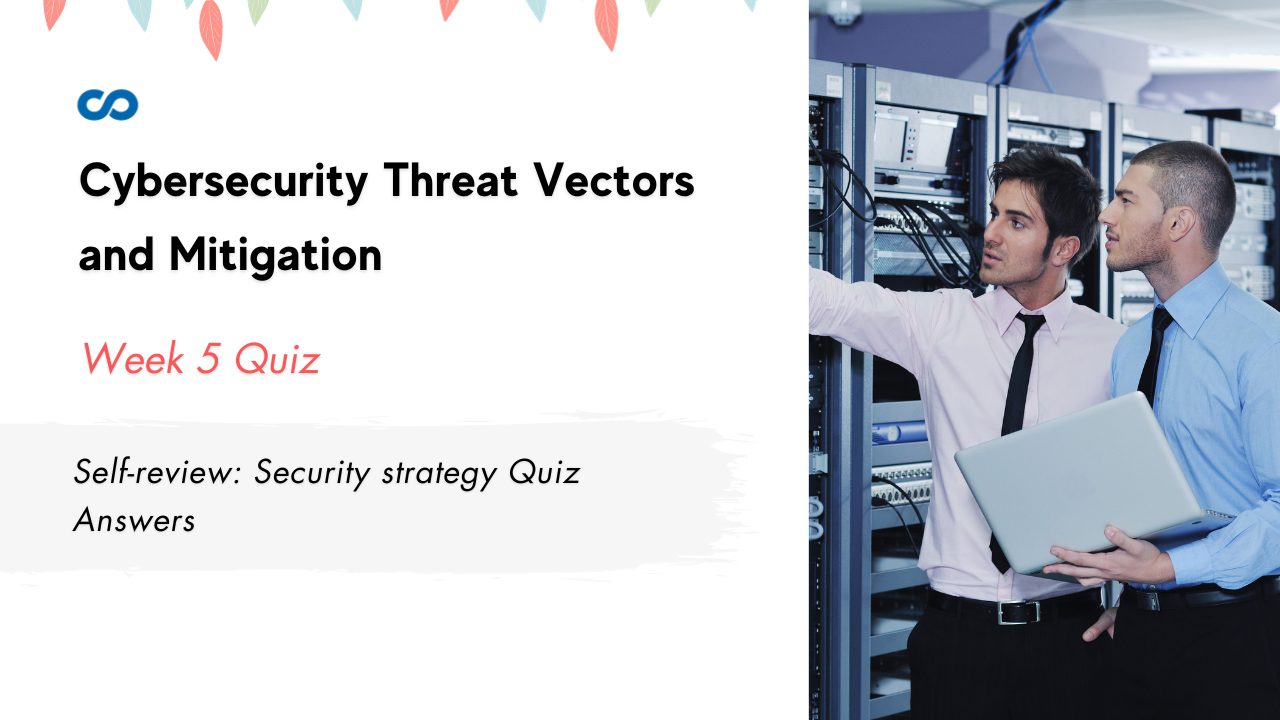Self-review: Security strategy Quiz Answers
In this article i am gone to share Coursera Course: Cybersecurity Threat Vectors and Mitigation by Microsoft Week 5 | Self-review: Security strategy Quiz Answers with you..
Enrol Link: Cybersecurity Threat Vectors and Mitigation
Cybersecurity Threat Vectors and Mitigation by Microsoft Week 5 Quiz Answers
Self-review: Security strategy Quiz Answers
Instructions
Overview
Congratulations on completing the Security strategy final course project, where you conducted a security analysis and developed a detailed security strategy report for Sam’s Scoops. Now it’s time to reflect on your application of key skills and concepts throughout the exercise. This self-review quiz will assess your understanding of the key concepts and how effectively you applied them to complete the exercise.
Question 1)
You conducted a security analysis for Sam. You had to identify all potential threats, internal and external, that Sam’s Scoops might face. What were the main objectives that you took into account while conducting the analysis?
- Designing a comprehensive data protection strategy and implementing MFA measures.
- Creating an incident response plan and proposing a plan for continuous monitoring.
- Decreasing the cost of IT infrastructure.
- Identifying potential threats, assessing risks, and formulating countermeasures.
Question 2)
At which step in the security strategy report creation process did you consider prioritizing threats based on their potential impact and likelihood of occurrence?
- Design a comprehensive data protection strategy.
- Develop countermeasures for each threat.
- Evaluate risks.
Question 3)
What is the purpose of developing countermeasures for each identified threat in the security strategy report?
- To assess the likelihood of each threat occurring.
- To mitigate risks and minimize the potential impact of each threat.
- To identify potential vulnerabilities and attack vectors.
Question 4)
What does a comprehensive data protection strategy typically encompass?
- Technological solutions only.
- Secure data storage and transmission, regular data backups, and robust access control measures.
- Employee training and policy changes only.
Question 5)
What is the purpose of an incident response plan in the security strategy report?
- To enable effective response and recovery from security incidents, and to prevent future occurrences.
- To identify potential threats and vulnerabilities.
- To prioritize threats based on their potential impact and likelihood of occurrence.
Question 6)
Sam’s Scoops allows their employees to use their personal devices in the shop. As part of developing the security strategy, you implemented a BYOD policy. What would be a primary security enhancement for this policy?
- Implementing log monitoring
- Implementing network segmentation.
- Enabling full disk encryption on all devices.
Question 7)
When you created the Phishing avoidance strategy, what was the primary solution for your strategy?
- Response protocols.
- Email filters and anti-malware software.
Question 8)
Several employees have installed unapproved software on their work computers. What is the most appropriate action you could take?
- Uninstall the unauthorized applications without notifying the employees involved.
- Ignore the issue if the applications are not harmful.
- Dispatch a company-wide email reiterating the policy against unauthorized applications.
- Identify the employees using unauthorized applications, inform them individually, and remove the applications.
Question 9)
Have you developed a continuous improvement plan for Sam’s Scoops’ security strategy?
- Yes, my plan includes regular security audits, employee training, and periodic review of security policies and procedures.
- I didn’t think a continuous improvement plan was necessary.
Question 10)
Does your plan consider the business context, including regulatory requirements and Sam’s Scoops’ rapid growth?
- My plan focuses on technical security measures and doesn’t consider the business context.
- My plan considers the business context, including regulatory requirements and the company’s rapid growth.

